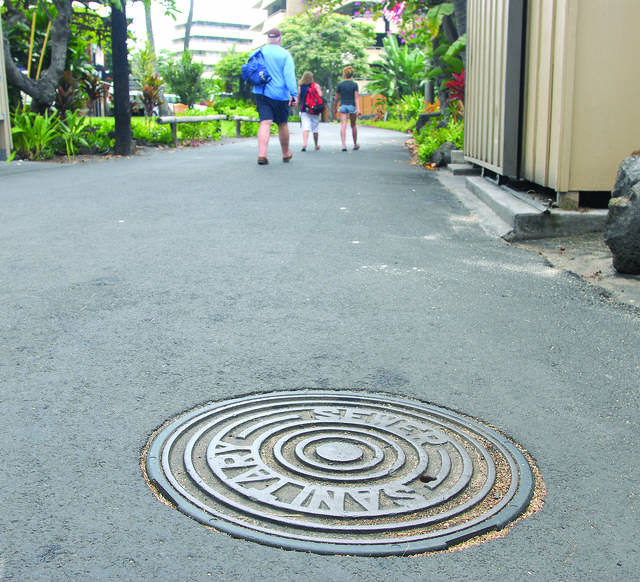Vacuum sewerage viable for some Hawaii Island sites

A sanitary sewer is pictured in front of Huggo’s restaurant on Alii Drive. (Laura Ruminski/West Hawaii Today, file)
KAILUA-KONA Suck it up.
KAILUA-KONA — Suck it up.
That’s the philosophy behind vacuum sewerage technology, one potential solution for certain parts of Hawaii Island the county eventually plans to sewer or re-sewer.
“It may be a better way if you’re worried about discharging sewage if you have some sort of problem,” said Bill Kucharski, Department of Environmental Management director.
John Radinoff of FLOVAC, an Australian company specializing in the technology, offered a presentation on the technology Tuesday in Kailua-Kona at the behest of the county’s Environmental Management Commission.
Vacuum sewerage is a system comprised of sturdy, plastic pipes that connect home and other building systems to collection chambers. Vacuum pumps and valves move collected waste onto a central pumping station once the chambers fill to a certain point. From the central station, waste is transferred to treatment centers like the Kealakehe Wastewater Treatment Plant.
Radinoff said vacuum systems are superior to the traditional pump systems in several ways. For one, HDPE pipes used in the process are impervious to saltwater, meaning no exfiltration causing breakdowns like the sewer pipe rupture on Alii Drive in June 2017 that sent filth into Kailua Bay.
Richard Bennett, chair of the Environmental Management Commission, said the U.S. Environmental Protection Agency estimates exfiltration due to aging pipes at 30 percent. That means potentially hundreds of thousands of gallons of sewage are polluting Hawaii oceans every day due to faults in the pipes carrying it.
Infiltration, or leaking pipes allowing water to come in, which in Hawaii often means saltwater that corrodes cast iron, isn’t a concern anywhere in the vacuum sewerage system except at a residential site. Monitoring technology also detects those issues quickly, allowing for easy finds and fixes. That’s because negative air pressure powers movement inside the lines.
“If you cut that pipe, it’s sucking in,” Radinoff said. “It’s not letting anything leak out.”
Pipes are also laid in shallow trenches 3-5 feet deep, making them easier to access for repairs. Absent manholes, the system also negates inflow — storm water draining into sewers and complicating water treatment once it reaches the treatment plant.
Vacuum sewerage first appeared in the U.S. back in the 1960s, begging the question: Why do exactly zero of these systems exist in Hawaii?
The answer is the system has limits, too. Namely, it can only pump water upward over very limited elevations. The topography of the state, not to mention Hawaii County, presents significant challenges.
“We’ve got mauka right to the sea,” Kucharski said.
Radinoff said his company uses gravity whenever possible to mitigate energy costs, which may make more of the island accessible depending on several factors. One consistent problem on Kailua-Kona slopes, however, would be the necessity of easements through private property to install pipes.
But some areas across the island, both sewered and not, are viable sites for vacuum sewerage. Kucharski said Puako on the Kohala Coast and the Hawaiian Homelands development in Keaukaha in East Hawaii are the two best examples of suitable areas — large, flat, coastal housing developments.
The unsewered area on Alii Drive, south of Queen Kalama Avenue on past Keauhou Bay, is also a region where the county could consider vacuum sewerage.
Radinoff conducted a cost projection study for a vacuum system at Puako, comparing it to projected costs of installing the traditional force main pump system.
Initial costs for a vacuum system came in at $8.125 million for the 159 lots it would service. The pump system is estimated at around $9 million.
Operations and maintenance costs per unit per year come out to $112 per lot in a vacuum system based on Radinoff’s calculations. Residents would pay $300 per lot for a traditional system built around a force main.
Kucharski said he’s aware of the numbers and DEM will consider its options.
“Coming in with a vacuum fit might be a better fit than a force main (for Puako),” he said. “But that’s something … we’d have to bid out. And if they came in with a better price, it’s something I would consider.”
Kucharski added vacuum sewerage could also make sense in areas where sewer infrastructure already exists, like main drags of Alii Drive. The county would never just replace everything, but as upgrades became necessary, gradual transitions could potentially occur.
“When it comes time to replace (sewer components), this is something I think deserves some consideration,” he said.


